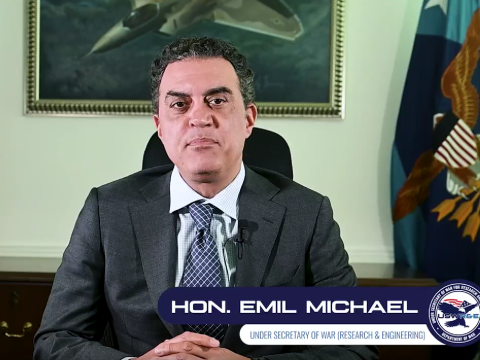Russia Weaponizes Increasingly Sophisticated Disinformation
The flood of disinformation from Russia has reached epidemic proportions as its leaders wage campaigns on multiple fronts. The coronavirus has provided a fertile medium for the spread of propaganda, and new technologies are promising a greater onslaught of disinformation aimed at eroding the world order.
Fighting disinformation that undermines Western institutions and U.S. policy goals is the Global Engagement Center (GEC). Lea Gabrielle, U.S. special envoy for the GEC, describes it as the mission center in an expanding network of partners all working together to counter foreign propaganda and disinformation. It has been in growth mode for the past 18 months, she allows.
“Russia has built a disinformation ecosystem that tries to promote anything that drives a wedge between the United States and our allies,” Gabrielle says. A report generated by the GEC cites five pillars of this ecosystem: official government communications; state-funded global messaging; the cultivation of proxy sources; weaponizing social media; and cyber-enabled disinformation.
While the circumstances may change, the underlying message remains the same. For example, Russia has used the COVID-19 pandemic to add a new layer to its false narratives about the United States, NATO and the European Union (EU). The pandemic shows that neither the EU nor the United States can protect their citizens, and NATO allies quickly lose their immunity in the face of a crisis, says the Russian propaganda.
Russian disinformation networks strive to advance Russian destabilizing foreign policy goals of creating confusion in democratic societies. Its campaigns are long-standing and are paired with advancing technologies that increase the range of their propaganda and the ease with which people accept it, she says.
One new trend is that Russia is aiming at nontraditional targets beyond Europe and the United States. Gabrielle notes that Russia’s proxies and disinformation network are reaching out to Africa and Latin America.
But while the Kremlin seeks to chaotically disrupt the world order to accomplish its goals, China’s disinformation has a different purpose, Gabrielle says. China is trying to reshape the world order to its own advantage. It is taking a whole-of-government approach employing political, economic, military and information tools to advance Chinese influence worldwide. Its Communist Party is spending billions of dollars using information tools both to silence criticism and to project a narrative favorable to Chinese interests.
Iran also has a disinformation machine that tries to undermine relations between the United States and its allies, she adds.
With these three adversaries targeting U.S. interests with disinformation, Gabrielle’s nightmare scenario is any propaganda that could lead to violence, death or public health problems. Other countries have suffered violent and fatal unrest arising from hate speech on social media, she notes. The GEC is countering disinformation on the spread of COVID-19, and China already has tried to discredit U.S. vaccine efforts.
The GEC aims to take the offensive rather than just be reactive, Gabrielle offers. This constitutes developing best practices, and it includes tapping overseas partners for their own expertise.
But the biggest challenge may lie in helping individuals adopt “healthy skepticism and best practices” when consuming information, she offers. Blunting these disinformation efforts takes multiple efforts. Key among these is to expose how the disinformation narratives are spread, Gabrielle states. “Educating the public builds resiliency and decreases vulnerability,” she declares. “It’s really important too for consumers of information, at the point of contact of information, to have critical thinking skills and to be considering the source and the vetting of that information before internalizing it or spreading it.
“Countering disinformation is a long-term effort, and everyone involved in this has to understand that,” Gabrielle continues. “It does require working with all of our partners—our international partner governments, the different organizations worldwide—to be able to build that societal resilience that is really key to reducing vulnerabilities. A well-informed citizenry is key to the strength of any democratic institution.”
Another countermeasure is to fill information voids with truth and accurate fact-based narratives. Part of stopping the spread of disinformation is to arm the people with factual information and incentives that they can use in their own personal networks.
Advanced technology plays a big role in enabling disinformation campaigns. In addition to deepfakes, which are falsified or synthetic imagery media, text creation tools are having an impact. Gabrielle cites one, GPT-3, that is an evolving synthetic text generator that produces human-like text. Typing a sentence into it gives it all it needs to develop a realistic-looking news article almost instantaneously. This article would look like it is source-embedded with quotes throughout, she relates.
Gabrielle explains that a GEC team of data scientists are using commercial off-the-shelf technology as the basis for their own home-grown technology to assess the information environment. And, the center is collaborating with academia and think-tank experts on the most difficult research issues. These groups have a broader capability for assessments and trend determinations.
The center also employs advertising technology to determine which narratives are more prominent or resonate with different audiences. Advertising technology also allows microtargeting to specific audiences, she adds.
Gabrielle points out that people tend to obtain what they believe is reliable information from friends and other trusted sources. However, during COVID-19, social distancing has cut down direct person-to-person contact and potentially forced people to rely more on social media, thus opening them up to more disinformation. She does not yet have data on how much of a shift, if any, has taken place.
A member of the GEC will be discussing disinformation issues in a panel discussion at the AFCEA/INSA Intelligence and National Security Summit, being held online September 16-18.





Comment
VERY important work.
VERY important work.
Thank you!
See you at the conference today!
Comments